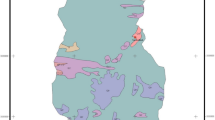Abstract
Rainwater samples harvested for drinking from the west part of Hebron (south of West Bank in Palestine), the largest city in the West Bank, were analyzed for the content of different trace heavy metals (Cr, Mn, Co, Ni, Cu, Zn, Mo, Ag, Cd, Bi, and Pb) by inductively coupled plasma mass spectrometry (ICP-MS). This study was conducted to determine the water quality of harvested rainwater used for drinking of south West Bank (case study, Hebron area). A total of 44 water samples were collected in November 2012 from 44 house cisterns used to collect rainwater from the roofs of houses. The samples were analyzed for their pH, temperature, electrical conductivity, total dissolved solids, and different heavy metal contents. The pH of all water samples was within the US Environmental Protection Agency limits (6.5–8.5), while some water samples were found to exceed the allowed WHO limit for total dissolved solids (TDSs) in drinking water. Results showed that concentrations of the heavy metals vary significantly between the 44 samples. Results also showed that the concentration of five heavy metals (Cr, Mn, Ni, Ag, and Pb) is higher than the WHO limits for these heavy metals in drinking water. Overall, our findings revealed that harvested rainwater used for drinking of this part of south West Bank is contaminated with heavy metals that might affect human health.



Similar content being viewed by others
References
Abderahman, N., & Abu-Rukah, Y. (2006). An assessment study of heavy metal distribution within soil in upper course of Zarqa River basin/Jordan. Environmental Geology, 49, 1116–1124.
Adekunle, I., Adetunji, M., Gbadebo, A., & Banjoko, O. (2007). Assessment of groundwater quality in a typical rural settlement in southwest Nigeria. Public Health International Journal of Environmental Research , 4, 307–318.
Alomary, A. (2013). Determination of trace metals in drinking water in Irbid City-Northern Jordan. Environmental Monitoring and Assessment, 185(2), 1969–1975.
Amin, M. T., & Alazba, A. A. (2011). Probable sources of rainwater contamination in a rainwater harvesting system and remedial options. Australian Journal of Basic and Applied Sciences, 5(12), 1054–1064.
APHA (American Public Health Association) (1998). Standard methods for the examination of water and wastewater, 20th Edition. Washington DC. 1294 p.
ARIJ (Applied Research Institute, Jerusalem) (1995). Environmental profile for the West Bank, volume 3: Hebron District.
Batayneh, A. T. (2010). Heavy metals in water springs of the Yarmouk Basin, North Jordan and their potentiality in health risk assessment. International Journal of the Physical Sciences, 5(7), 997–1003.
Chen, C., Kao, C., Chen, C., & Dong, C. (2007). Distribution and accumulation of heavy metals in the sediments of Kaohsiung Harbor, Taiwan. Chemosphere, 66, 1431–1440.
Despins, C., Farahbakhsh, K., & Leidl, C. (2009). Assessment of rainwater quality from rainwater harvesting systems in Ontario, Canada. Journal of Water Supply: Research and Technology-AQUA, 58, 2.
Dupler, D. (2001). Heavy metal poisoning. Gale Encyclopedia of alternative medicine. Farmington Hills, Gale group. 2054–2057.
Ferner, D. J. (2001). Toxicity and heavy metals. eMedicine Journal, 2(5), 1.
Gutierrez, R., Rubio-Arias, H., Quintana, R., Ortega, J., & Gutierrez, M. (2008). Heavy metals in water of the San Pedro River in Chihuahua, Mexico and its potential health risk. International Journal of Environmental Research and Public Health, 5, 91–98.
Ismail, I., & Saleh, I. M. (2012). Analysis of heavy metals in water and fish (tilapia sp.) samples from Tasik Mutiara, Puchong. The Malaysian Journal of Analytical Sciences, 16(3), 346–352.
Kar, D., Sur, P., Mandal, S., Saha, T., & Kole, R. (2008). Assessment of heavy metal pollution in surface water. International Journal of Environmental Science and Technology, 5, 119–124.
Magyar, M. I., Mitchell, V. G., Ladson, A. R., & Diaper, C. (2008). Lead and other heavy metals: common contaminants of rainwater tanks in Melbourne. Water Down Under, 2008.
Mizyed, N. (2009). Impacts of climate change on water resources availability and agricultural water demand in the West Bank. Water Resources Management, 23, 2015–2029.
Momot, O., & Synzynys, B. (2005). Toxic aluminium and heavy metals in groundwater of middle Russia: health risk assessment. International Journal of Environmental Research and Public Health, 2, 214–218.
Mosley, L. (2005). SOPAC water quality officer, water quality of rainwater harvesting systems. SOPAC Miscellaneous Report, 579.
Ong, M., & Kamaruzzaman, B. (2009). An assessment of metals (Pb and Cu) contamination in bottom sediment from South China Sea Coastal Waters. Malaysian American Journal of Applied Sciences, 6, 1418–1423.
Roberts, H. (1999). Lead poisoning. http://www.setlet.com. Accessed 2 Jan 2013
Voica, C., Kovacs, M. H., Dehelean, A., Ristoiu, D., & Iordache, A. (2012). ICP-MS determinations of heavy metals in surface waters from Transylvania. Romanian Journal of Physics, 57(7–8), 1184–1193. Environmental Physics.
WHO (1993). Guidelines for drinking water quality. 2nd edition. Volume 1: recommendations. Geneva: WHO, 49–50.
WHO (2003). Total dissolved solids in drinking water, background document for development of WHO guidelines for drinking water quality (WHO/SDE/WSH/03.04/16).
Acknowledgments
The authors are grateful for the German research funding organization (Deutsche Forschungsgemeinschaft (DFG)) for their financial support through TRION project.
Author information
Authors and Affiliations
Corresponding author
Rights and permissions
About this article
Cite this article
Malassa, H., Al-Rimawi, F., Al-Khatib, M. et al. Determination of trace heavy metals in harvested rainwater used for drinking in Hebron (south West Bank, Palestine) by ICP-MS. Environ Monit Assess 186, 6985–6992 (2014). https://doi.org/10.1007/s10661-014-3904-5
Received:
Accepted:
Published:
Issue Date:
DOI: https://doi.org/10.1007/s10661-014-3904-5




